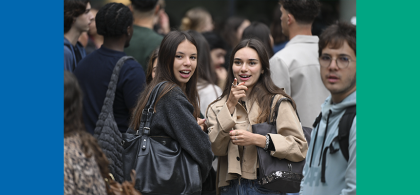
New skills needs, new pedagogic methods
After being viewed as gadgets in classrooms, new technologies are now reaching their maturity. We now know how to use them properly through the right amount of exposure to them. Here how NEOMA is applying them.
How to educate the young generation, with the requirements it has, to the professional world of tomorrow is the concern that guides NEOMA in its choice of applied educational methods. “Pedagogic innovation must aim to help students succeed with or without the help of technology”, said Haithem Marzouki, dean of innovative pedagogy and professor of finance at the business school. “In a world that is rapidly changing, students must continue to learn through their entire lives. We set them up for this. We give them the reflexes to seek out information and stay in the know”. One of the objectives is thus to teach students how to learn. To do this, NEOMA has developed asynchronous remote learning with content that students can access at any time. They thus have a wealth of documentation, podcasts, interactive slides, videos, etc. which can make them more independent in their education.
Content that adopts student behaviours
“These last two years, we greatly developed the quality of the asynchronous system”, the dean said. “Our entire course design team worked very hard to build sessions that adopt the behaviours and approaches of the new generation: gamification, interactivity, simulation, etc. In 2023, the school deployed iLearning, interactive, scenario-based courses designed much like a web series. Students can virtually work in a specific position like chief digital officer for example. This compels them to make decisions, supervise studies and develop knowledge in a fun way. They remain very active in their education. Each step is validated by a test that then allows them to move on to the next lesson. In this way, we ensure that they truly acquired the knowledge.
“One of the major advantages of asynchronous learning is putting everyone on the same level”, the finance professor continued. “Remotely, each student learns at their own pace. The fast learners can go farther and the slow learners can take their time. In the same class, students sometimes come from different backgrounds and they have different learning abilities. In the classroom, that can create a gap. Through these asynchronised courses, the groups are no longer homogenised, the theoretical fundamentals are mastered, and the students can move on to case studies or discussions. Students become more active and the in-class sessions become more interesting”.
Data-driven courses
On these learning platforms, the students generate the data. They are displayed on a dashboard that sums up the development of each person. With this tool, professors can identify the progress and obstacles of certain students and change their approach and the course content if they feel it necessary. It’s what is called adaptive learning, a trend that has entered education in the world of data-driven pedagogy. If the students are progressing slowly on a certain concept, the teacher can then see that he or she has to explain it more clearly. Conversely, if students are picking up the concepts quickly, then there’s no reason to review the material. “The courses have greater depth and more added value for the students”, Haithem Marzouki said. “Before, I didn’t have the means to monitor how each student was learning outside the classroom. Now, I can review it and adapt my teaching. I know that such a method is better adapted to such a level or such a programme.
“In this method generative artificial intelligence also comes into play. Sometimes to renew the course we use it so we can progress even farther and develop activities to answer the basic questions from students. But they then have to verify it. That is how we develop their ability to reflect, which has become indispensable in the age of AI. It will be more useful than the ability to memorise information. It is completely changing how we teach courses”.
For Haithem Marzouki the teacher’s role has changed greatly over the past decade. “Teachers are now more facilitators, coaches, experts who enable students to structure their way of thinking and responding to issues, questions and especially developing critical thinking”. In short, it is no longer as much of a top-down method as it was before.



